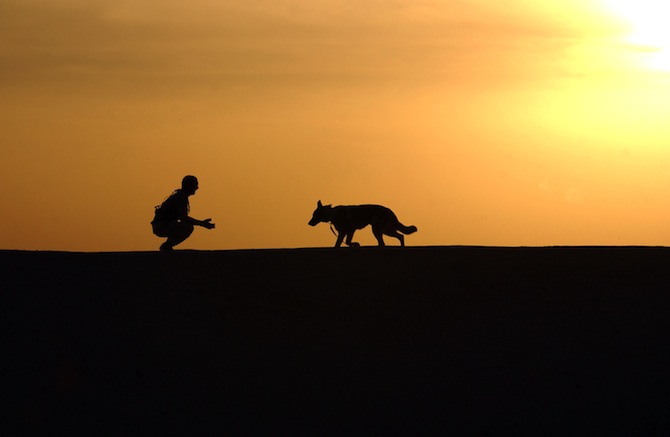“Studies have confirmed that dogs, like preverbal infants, are aware of the intentional dimension of communication, an interspecies social skill that not even apes possess.”
Have you ever felt as though your dog is trying to talk to you? Not in the literal sense of course (although sometimes I swear my dog actually can speak); that adorable little head tilt that we find so endearing might be an attempt at understanding what it is you’re saying to him, as though straining to find a familiar word. Dogs are one of the only mammals capable of comprehending referential gestures (pointing) and emotional facial expressions. Studies have confirmed that dogs, like preverbal infants, are aware of the intentional dimension of communication, an interspecies social skill that not even apes possess. Tear-jerking stories constantly pop up on our Facebook news feeds about heroic dogs who, using these intuitive communication skills, have come to the aid of their human masters. An assistance dog named Endal was one such hero who was crowned Dog of the Millennium after saving his disabled owner’s life following a road accident. Or Max, the red collie who sensed that his owner Maureen had cancer despite her mammogram results coming back clear. It seems that sometimes our loveable pooches know us better than we know ourselves.
Domesticated wolves
These remarkable and unique behaviours are not apparent in wolves, the big bad ancestors of domesticated dogs. The dog and wolf are in fact the same species with the latter being the largest member of the Canidae family. Dogs are simply domesticated wolves with DNA sequencing studies confirming a common ancestor with the gray wolf. The physiology of many dog breeds is similar to wolves, but their instincts and temperament are fundamentally quite distinct.
The evolutionary origins of the domesticated dog or Canis familiaris remain controversial and elusive. Some researchers suggest a domestication process beginning in East Asia around 15,000 years ago while others have provided evidence of a split between wolves and Chinese indigenous dogs as far back as 32,000 years ago. The domestication of animals (including our canine companions) from their feral ancestors is a remarkable evolutionary story relying on the artificial selection of particular traits by ancient human populations. In dogs, these included characteristics such as tameness and reduced fearfulness of humans, subsequently warranting the evolution of social skills enabling enhanced communication and cooperation with their human masters.
Cooperating with humans
A compelling new study by scientists at Linköping University in Sweden has identified five genes in dogs associated with their ability to seek out human interaction, four of which are related to social disorders in humans.
Dogs were presented with an unsolvable task whereby they were able to manipulate a device allowing easy access to two treats, but the third treat remained inaccessible. At some point in the study this obstacle prompted most of the dogs to seek cooperation from a nearby human, exhibited mainly by increased eye contact and physical proximity. The dogs were then genotyped with a HD Canine SNP-chip to ascertain the genetic basis for any variation seen during the unsolvable task experiment. A SNP or single nucleotide polymorphism is a variation in a single nucleotide occurring at a particular position in the genome. SNPs account for the most common types of genetic variation found among individuals. A Genome-Wide Association Study (GWAS) examines a set of genetic variants, like SNPs, across the genome of different individuals to ascertain if a variant is associated with a particular trait. In this study, lead by Professor Per Jensen, the group wished to identify potential candidate genes that might elucidate further our understanding of the social behaviour unique to dogs that has been molded during the course of their evolution.
Three SNPs within two different genes located on chromosome 26 were found to be associated with the tendency for each dog to seek human contact. A gene called SEZ6L was also found to be significantly associated with the behaviour observed during this study. In humans, SEZ6L has recently been linked with autism spectrum disorder, a neurodevelopmental condition that impairs a child’s ability to communicate and interact with others. Other studies have revealed certain SNPS in the SEZ6L gene linked to bipolar disorder. Suggestive associations in the ARVCF, TXNRD2 and COMT genes (associated with schizophrenia) were also identified within the same genomic regions of dogs displaying human seeking behavior. These additional findings stress the importance of social adaptations acquired by domesticated dogs, the evolution of which has been so tightly intertwined with their relationship to humans. According to the authors of this recent paper which appeared in last month’s edition of Scientific Reports, the findings may prove dogs to be highly valuable for mapping certain behavioural disorders specific to both species. For instance, OCD, which has been genetically mapped in Doberman pinchers, manifests in a similar manner in both dogs and humans.
A unique relationship
Research carried out by Professor Jensen’s group and others have given us a deeper insight into the genetics of interspecies communication and the social interaction that is so unique to dogs and humans. In addition to informing us on the evolutionary process of domestication in dogs we can potentially learn more about ourselves from our canine companions through genetic studies on social behavioural disorders.
The relationship between dogs and humans has had a profound impact on our lives throughout the centuries. Napoleon Bonaparte, upon finding a dog beside the body of his master on the battlefield wrote about a scene that remained with him until his death: “This soldier, I realized, must have had friends at home and in his regiment; yet he lay there deserted by all except his dog. I looked on, unmoved, at battles which decided the future of nations. Tearless, I had given orders which brought death to thousands. Yet here I was stirred, profoundly stirred, stirred to tears. And by what? By the grief of one dog.”







